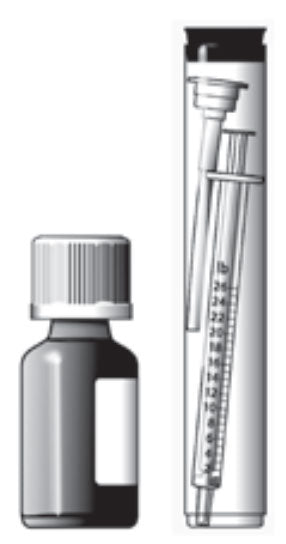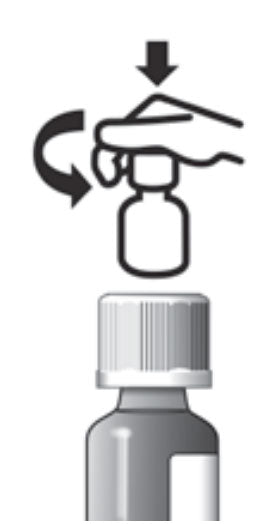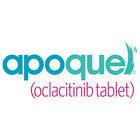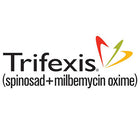Atopica Oral Solution for Cats
Atopica for Cats is an oral solution to help control feline dermatitis. Some signs of allergic skin disease include itching, chewing, licking, skin lesions, and hair loss. Comes in an easy-to-administer liquid. Calms and soothes your cat's skin.
- Manages allergic skin condition in cats
- Greatly decreases the sensation of itchiness and visible skin sores.
- Arrives in a simple-to-use liquid form and comes with an oral syringe.
- Many cats like the flavor, but can be combined with their meals.
Prescription items are NON-RETURNABLE and NON-REFUNDABLE.
Please note product may arrive in a Hardy Paw Pharmacy vial, manufacturer packaging is shown for reference.
DOSAGE AND ADMINISTRATION:
Always provide the Instructions for Assembling the Dispensing System and Preparing a Dose of ATOPICA for Cats and the Information for Cat Owners with a prescription.
The initial dose of ATOPICA for Cats is 3.2 mg/lb/day (7 mg/kg/day) as a single daily dose for a minimum of 4 to 6 weeks or until resolution of clinical signs. Following this initial daily treatment period, the dose of ATOPICA for Cats may be tapered by decreasing the frequency of dosing to every other day or twice weekly to maintain the desired therapeutic effect. ATOPICA for Cats should be administered directly on a small amount of food or orally just after feeding. Whenever possible, ATOPICA for Cats should be administered on a consistent schedule concerning meals and time of day. If a dose is missed, the next dose should be administered (without doubling) as soon as possible, but dosing should be no more frequent than once daily.
The dispensing system includes an oral dosing syringe graduated in 1 lb increments. To dose the cat, the syringe should be filled to the nearest 1 lb corresponding to the cat’s body weight (round down if 0.1 to 0.4 lb, round up if 0.5 to 0.9 lb). Each pound graduation on the syringe delivers a volume of 0.032 mL providing 3.2 mg/lb. Do not rinse or clean the oral dosing syringe between uses. (See Instructions for Assembling the Dispensing System and Preparing a Dose of ATOPICA for Cats)
Instructions for Assembling the Dispensing System and Preparing a Dose of ATOPICA for Cats (cyclosporine oral solution) USP MODIFIED.
Assembling the Dispensing System
The dispensing system consists of 4 parts:

- A bottle containing the medicine, with a rubber stopper and a screw cap to close the bottle after use.
- A plastic adapter with a dip tube that you will push into the neck of the bottle. The adapter must always remain in the bottle after first use.
- An oral dosing syringe that fits into the top of the plastic adapter to withdraw the prescribed dose of medicine from the bottle.
- A plastic vial containing the plastic adapter and oral dosing syringe. Save the plastic vial to store the oral dosing syringe between each use.

- Remove and save the screw cap.
- Remove and dispose of the rubber stopper.
- Hold the open bottle upright on a table and push the plastic adapter firmly into the neck of the bottle as far as you can, then close the bottle with the screw cap.
- To provide a child-resistant closure, push down on the child-resistant screw cap as you turn it.
Note: To prepare a dose, carefully follow the instructions for Preparing a Dose of Medicine.
Preparing a Dose of Medicine

- Push and turn the child-resistant screw cap to open the bottle. Note: Always close the bottle with the child-resistant screw cap after use.
- Check that the plunger of the oral dosing syringe is pushed down.
- Keep the bottle upright and insert the oral dosing syringe firmly into the plastic adapter.
- Slowly pull the plunger up so that the oral dosing syringe fills with the medicine.
- Expel any large bubbles by pushing and pulling the plunger a few times. The presence of a few tiny bubbles is not important for dosing accuracy.
- Withdraw the dose of medicine prescribed by your veterinarian. The scale on the oral dosing syringe corresponds to the cat’s body weight.
Note: If the prescribed dose is more than the maximum volume marked on the oral dosing syringe, you will need to reload the syringe to withdraw the full dose.
- Remove the oral dosing syringe by gently twisting it out of the plastic adapter.
You can now place the oral dosing syringe over a small amount of food or introduce the syringe in the mouth of your cat and push the medicine out of the syringe. See Information for Cat Owners for complete administration instructions.
Do not rinse or clean the oral dosing syringe between uses. Store the oral dosing syringe in the plastic tube between each use.
ATOPICA for Cats should be stored in the original container at room temperature between 59 and 77°F. Once opened, use contents within two months for the 5 mL container and 11 weeks for the 17 mL container.
Close the bottle with the child-resistant screw cap after use.
Keep out of reach of children!

Always close the bottle with the child-resistant screw cap after use. To provide a child-resistant closure, push down on the child-resistant screw cap as you turn it.
Storage Information:
ATOPICA for Cats should only be dispensed in the original container and stored at controlled room temperature between 59 and 77°F (15-25°C). Once opened, use contents within two months for the 5 mL container and 11 weeks for the 17 mL container.
FAQ
- What is Atopica for Cats:
- Atopica for Cats (cyclosporine modified) is an immunosuppressant available by prescription. Atopica for Cats is FDA-approved for use in the treatment of feline allergic dermatitis in cats at least 6 months of age and weighing at least 3 pounds. Atopica for Cats is available as 5ml and 17ml oral solutions and comes with an oral syringe. The usual dose of Atopica for Cats is 3.2 mg/lb (7 mg/kg) orally 1 time a day for 4-6 weeks. Following this, the dose may be tapered every other day or twice weekly as needed to maintain the therapeutic effect. Dosing of the liquid formulation is accomplished by a syringe that is marked with weight bands for easy dosing.
- What should I discuss with my veterinarian before giving Atopica for Cats:
- Tell your veterinarian if your pet has liver disease, kidney disease, cancer, high blood pressure, a viral, bacterial, or fungal infection, or any other serious or chronic condition. Tell your veterinarian if your cat is pregnant or lactating, and if you plan to breed your cat.
- How should this medication be given:
- Give Atopica for Cats exactly as directed by your veterinarian. If you do not understand these directions, ask your veterinarian or pharmacist to explain them to you. Always give Atopica for Cats with food or following a meal. Allow plenty of water for your pet to drink. Store Atopica for Cats at room temperature away from moisture and heat. Wash hands after administration. People with known hypersensitivity should avoid contact with atopica.
- What happens if I miss giving a dose:
- Give the missed dose as soon as you remember. If it is almost time for the next dose, skip the dose you missed and give the next regularly scheduled dose. Do not give a double dose unless otherwise directed by your veterinarian.
- What happens if I overdose my pet:
- Seek emergency veterinary medical treatment.
- What should I avoid while giving Atopica for Cats to my pet:
- The safe use in breeding, pregnant, or lactating cats has not been determined. Do not use Atopica for Cats in cats with a known allergy to the medication. The drug should not be used in cats with kidney disease, stomach ulcers, and certain blood disorders. Prolonged use of Atopica for Cats can result in bacterial or fungal infection related to a decreased effect on the immune system. During treatment, cats should avoid exposure to toxoplasma gondii.
- What are the possible side effects of Atopica for Cats:
- If any of the following serious side effects occur, stop giving Atopica to Cats and seek emergency veterinary medical attention: an allergic reaction (difficulty breathing, swelling of the lips, tongue, or face, and hives). Other less serious side effects may occur. Continue giving Atopica for Cats and talk to your veterinarian if your pet develops vomiting, soft stools or diarrhea, muscle cramps, muscle weakness, weight loss, loss of appetite, and change of hair coat. Persistent, progressive weight loss may result in hepatic lipidosis; monitoring of body weight is recommended. Other side effects may occur. Talk to your veterinarian about any side effect that seems unusual or bothersome to your pet.
- What other drugs will affect Atopica for Cats:
- Many drug/drug interactions occur when taking Atopica for Cats. Tell your veterinarian what medications your pet is currently using and any new products, including herbal remedies you may start to give. Drug/drug interactions could cause a decrease in effectiveness or an increase in side effects of either Atopica for Cats or the other medication being given. Examples of medications that may cause drug/drug interactions are: SMZ-TMP (Bactrim, Septra), gentamicin, etodolac (EtoGesic), piroxicam (Feldene), ketoconazole (Nizoral), cimetidine (Tagamet), ranitidine (Zantac), itraconazole (Sporanox), methylprednisolone (Medrol), erythromycin, Allopurinol (Zyloprim), metoclopramide (Reglan), prednisolone, digoxin (Lanoxin), any type of vaccination.
Recommended for the Atopica 100mg/ml Oral Solution for Cats
Product title
Vendor
$19.99 | $24.99
Product title
Vendor
$19.99 | $24.99
Product title
Vendor
$19.99 | $24.99
Product title
Vendor






















